
the azwa maryam is one of the few circular churches with a thatched roof left. corrugated iron is of course a more sustainable material. it protects the church better against water and fire. but the building gets rid of its charm.
the outer wall is a simple colonnade with square columns and a 1,5 m high reed screen. the church stands on a four stepped plinth. the church bell is a big stone. you cannot ring it, you must beat it to get the harmonious answer.

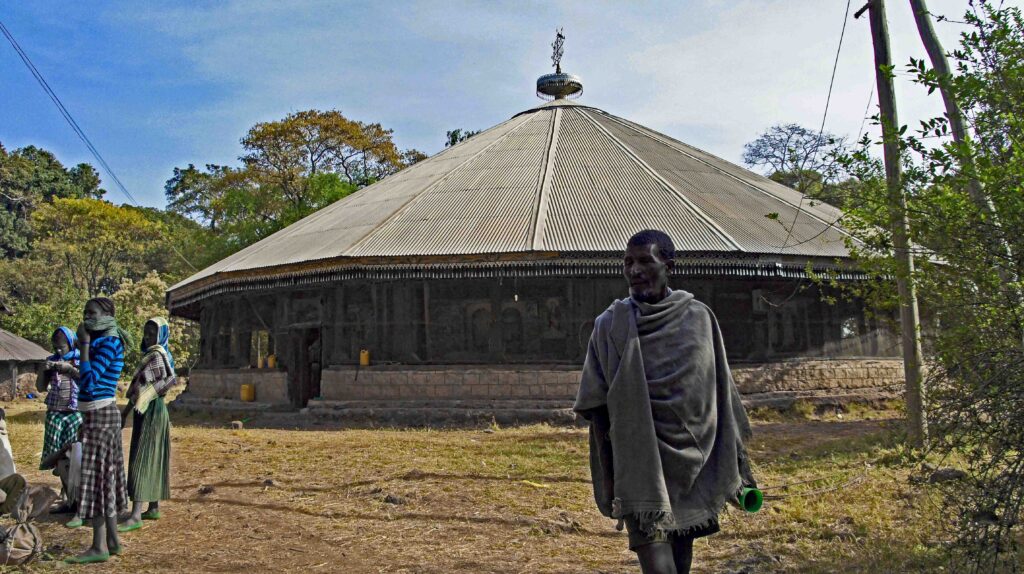
more an more churches like the windjeta debre mikael, have been robbed of their character and charm, because their thached roof has been replaced by a corrugated iron one.
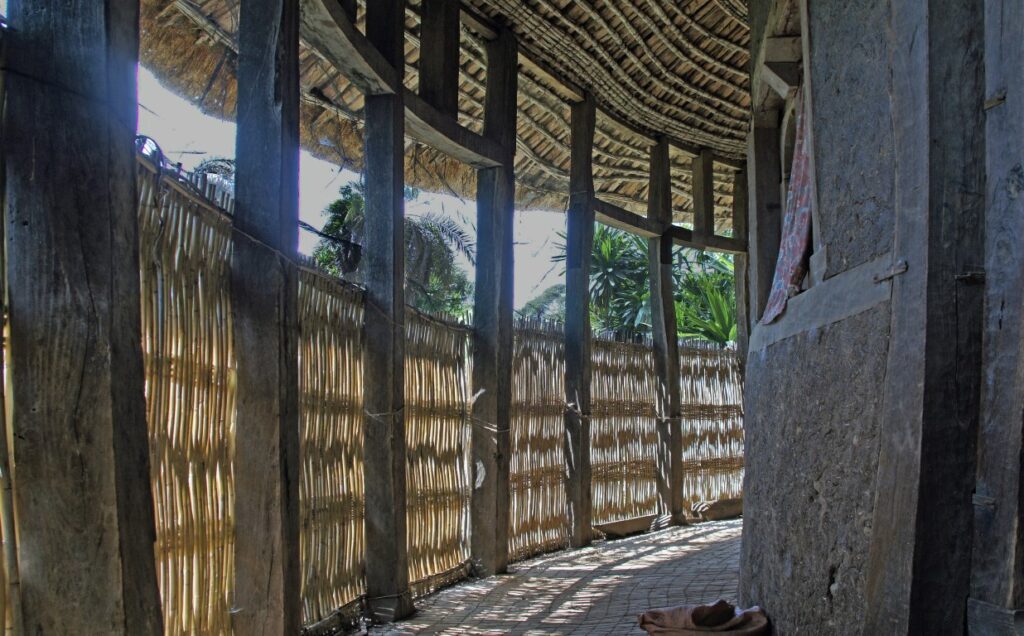
the space between the outer wall and the reed screen is a pleasant place to stay and/or pray, protected against sun and rain. masses and other ceremonies are mainly held in the open air. one enters only to receive holy communion. in traditional churches there is not enough space to accomodate a large number of people.
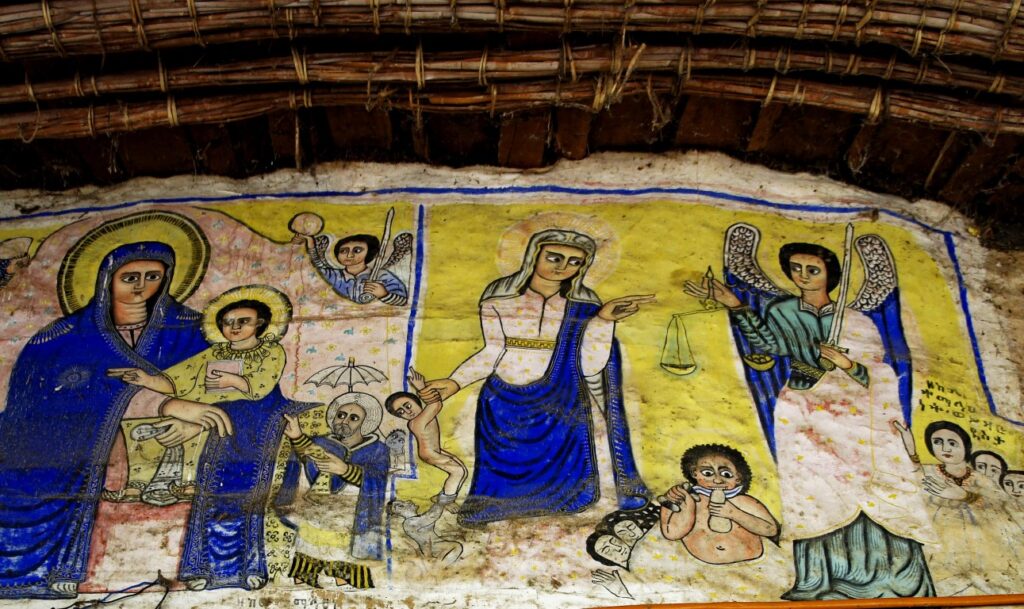
the paintings outside emphasize the patronage of the holy virgin mary. to the left her motherhood, to the right the story of belayseb, illustrating the pact of mercy between mary and her son.
belayseb, a sinful cannibal, once met a leper, who begged for a sip of water, for mary’s sake. belayseb did so. when he died mary pleaded his case with the archangel michael.
she has the soul of the sinner in her right hand, while the devil pulls at his feet. michael has the skulls of belayseb’s victims in his right scale, but the sip of water in the left scale outweighs the countless crimes of the cannibal, because he had given the water for mary’s sake. so saint peter opened the gates of heaven to let him in.
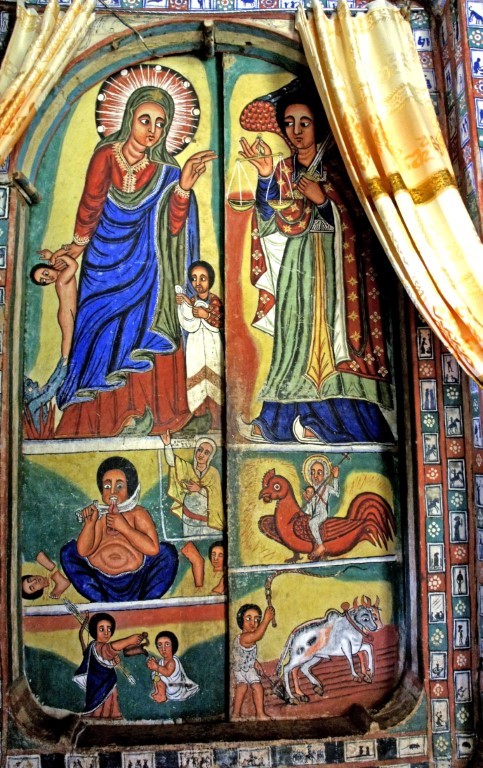
the story of belayseb can be fiund inside many churches on the south wall door. in this church too. notice the differences in style

in ethiopian churches the pictures on the four walls of the maqdas follow about the same patterns.
west: stories of the life of jesus christ
south: stories of the virgin and jesus’ childhood
east: teachings and miraculous cures of christ
north: equestrian saints and martyrdoms of male saints
THE WEST WALL
visitors of a church will normally be lead counterclockwise through a church: west – south – east – north.
the main entrance, always in the west, is most suitable to introduce christ to visitors who come from all over the world to admire the paintings. on the drum the holy trinity, christ in his most mystical form, 3 =1 !!
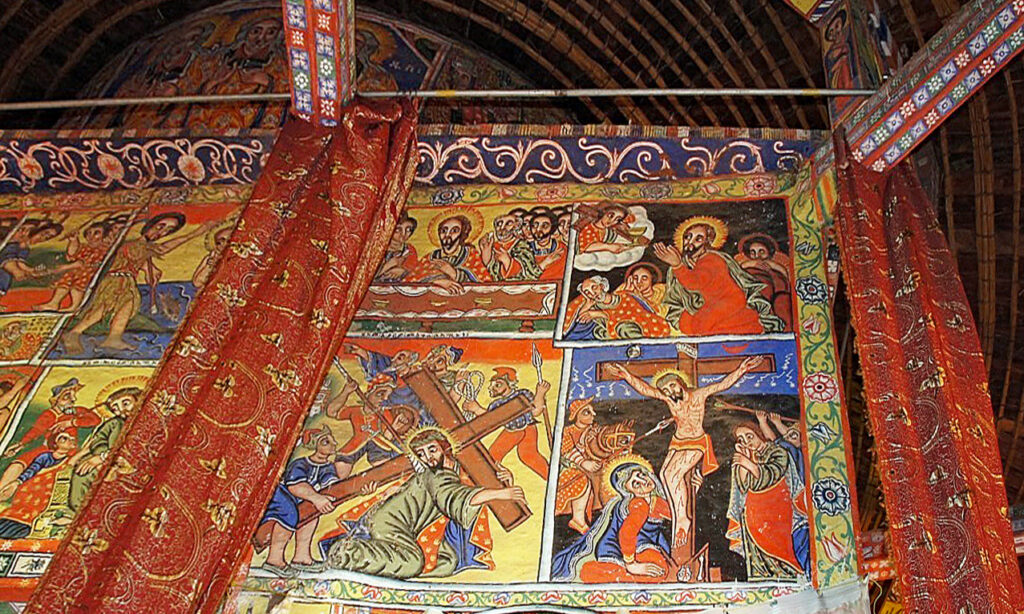
between the curtains four episodes of the passion: the last supper, agony in the garden of gethsemane, christ assisted by simon of cyrene and the crucifixion.
during the last supper judas leaves prematurely to betray jesus to the roman soldiers. he will receive 30 pieces of silver for this heroic act. we cannot see him here, he hides behind the left curtain.
three apostles peter, john and jacob are with jesus in the garden of gethsemane. he begs them to stay awake because he is in agony. aware of his coming torture he is sweating blood. when he turns to his apostles, he sees them deeply asleep. he feels abandoned.
jesus must carry his own cross on the way to golgotha. when he falls for the third time the soldiers beat him up and a centurion commands simon of cyrene to help jesus carry the load.
the crucifixion reads from above: the sun turns black, the moon blood red and the stars are falling down.
the day turns dark as night. the mounted centurion longinus with his spear opens a sixth wound in jesus’ side. stephaton offers jesus a drink, a sponge soaked in vinegar, on the tip of a wooden stick. john cries bitter tears over the loss of his cousin jesus. mary embraces the cross as she swoons.

a summary of jesus’ birth and dearh.
the angel gabriel visits mary and tells her she will be pregnant through the holy spirit and give birth to a son of god. she must call him jesus. the angel points at the dove above his head, representing the holy spirit. mary seems to be shocked, but gabriel comforts her by offering her a white flower as a token of her virginity. at the birth of jesus joseph grabs his head in despair. he never touched her! then how can she give birth?
after the last supper judas iskariot betrays his master in the garden of gethsemane. jesus is 33 years of age. apparently judas regretted his betrayal, as he has prostrated himself and tries to kiss jesus’ left big toe. the little devil on his back doesn’t seem to aprove. when the roman soldier malchus attacks jesus, peter draws his sword and cuts off the ear of malchus. jesus picks it up and puts it back. then he is led away to be crucified.

but before the crucifixion takes place the roman soldiers amuse themselves by tormenting and mocking jesus. they tie him to a pole and beat him with ropes and palm branches until he bleeds all over.
then they pull an elegant cloack over his aching and bleeding body. they put him barefooted on a ’throne’. with two sticks they hammer a crown of thorns on his head, one of them kneels before him shouting sarcastically: “now you really look like the king of jews”. these words refer to the caption nailed on top of the cross: i n r i , meaning iesus nazarenus rex iudeorum.

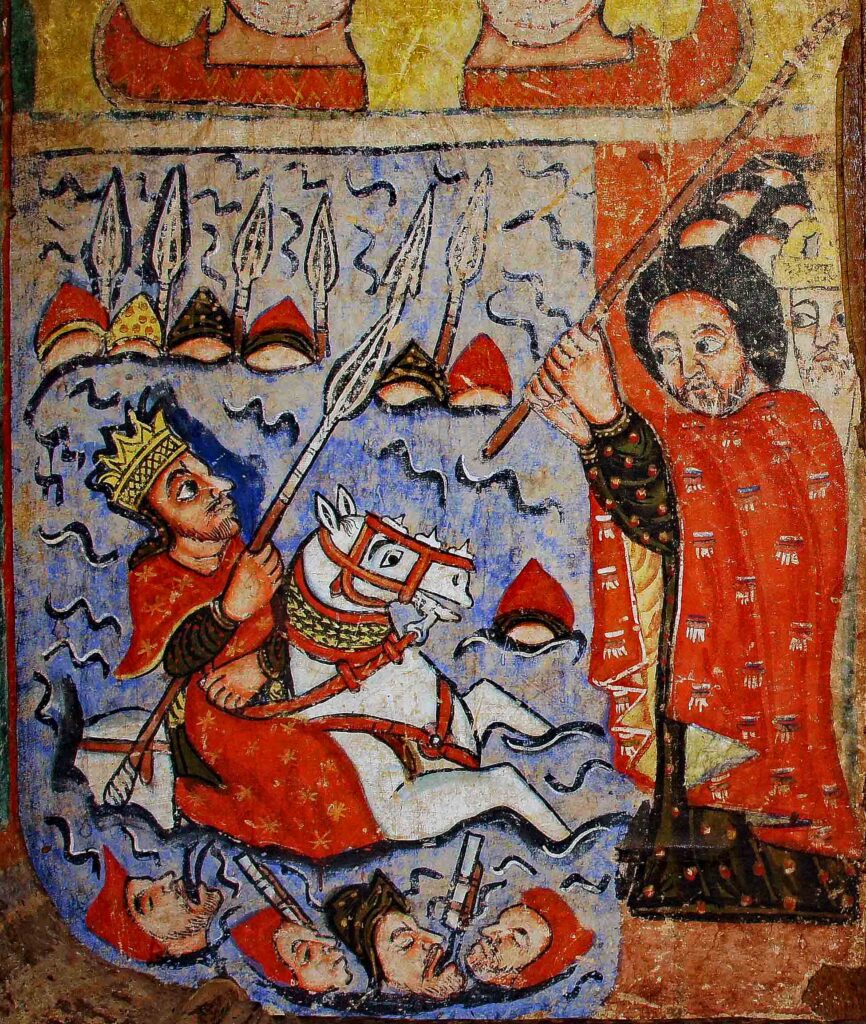

two archangels serve as gatekeepers at the entrance.michael wields his sword and raphael raises his lance. under michael’s feet moses is closing the waters of the red sea.
after the passage of the read sea, moses and the pharaoh are still threatening each other. the brave egyptian soldiers are sinking deeper and deeper, the pharaoh will soon follow them, moses had definitely chosen a favorable location to pass through. that could have been quite a job, if one takes into account that the red sea reaches a depth of over 2000 meters.
a church dedicated to raphael, was built on an island near alexandria. on the day of the dedication the new building started to shake. the church appeared to have been built on the back of a whale. the startled communion started to pray and look! the archangel himself came to rescue his church. he grabbed his lance and fixed the whale to the bottom of the sea. the church was save now, until…!
in the 17th century the muslim world expanded rapidly. raphael noticed how his church was desecrated by the blasphemic caliph and his gang. he got furious and tore his lance loose. he ordered the whale to descend to the deepest depths of the mediterranean. and so it happened and justice was done.

once upon a time a lebanon’s king had a beautiful daughter with the lovely name of birutawit. a local dragon, sensitive to feminine beauty, thought she would be a delicious bite. he used all his charms to approach her. but the princess mistrusted him and climbed into the highest tree in the neighborhood,
saint george happened to pass by, as usual on his white stud. he noticed the princess’ distress. without hesitation he thrust his spear into the monster’s tail to calm it down. then he dismounted, leashed the monster and handed it over to the princess. birutawit delighted her royal father with this exotic animal. saint george galopped away, glad to have once more reaffirmed his reputation as a holy man.
ethiopian painters often do their best to depict saint george and the dragon most gracefully and with a lot of fantasy. vivid colors and movements of the protagonists result in a kind of expressiveness, rare in traditional ethiopian painting.
traditionally the background of an ethiopian painting is red, yellow and green, the colours of the flag. the white horse is placed against a green backgtound for the highest contrast. on the other hand, the bright blue dragon is placed against a yellow background. blue on green is not rich in contrast and less aesthetic. yellow dots appear in all other part of the dragon’s body.
movement can be seen in the spears and in the horse’s legs. the hind legs are on the ground, the front legs in the air as the horse is jumping. violent movement is seen in the dragon. look at its raised head, the wide opened eye and jaws, turned into the opposite direction of the body, in impotent rage. the ultimate rage is expressed by its spiralling tail. or is it anger intensified by flashing pain, caused by the horse’s left hind leg!!?
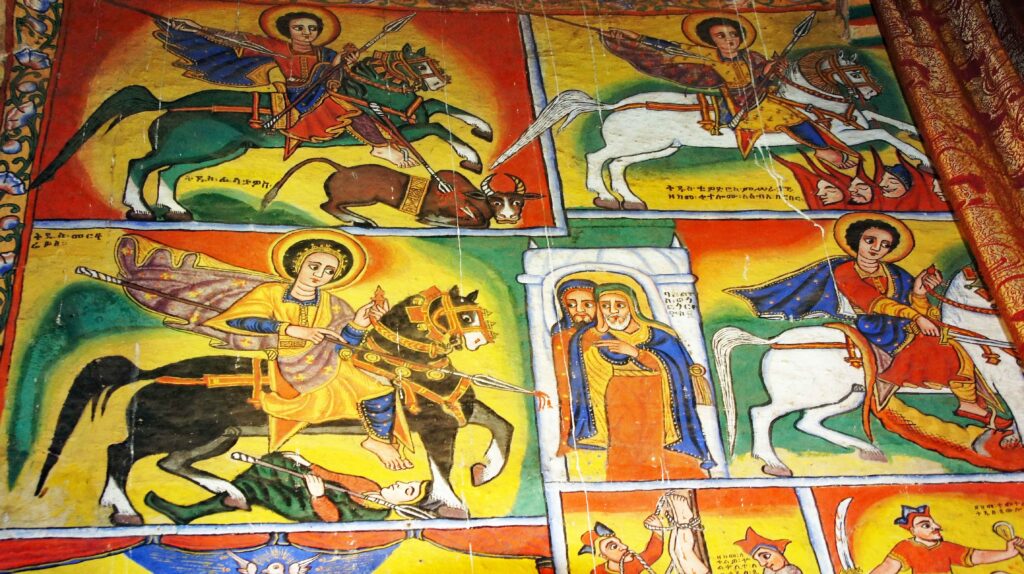
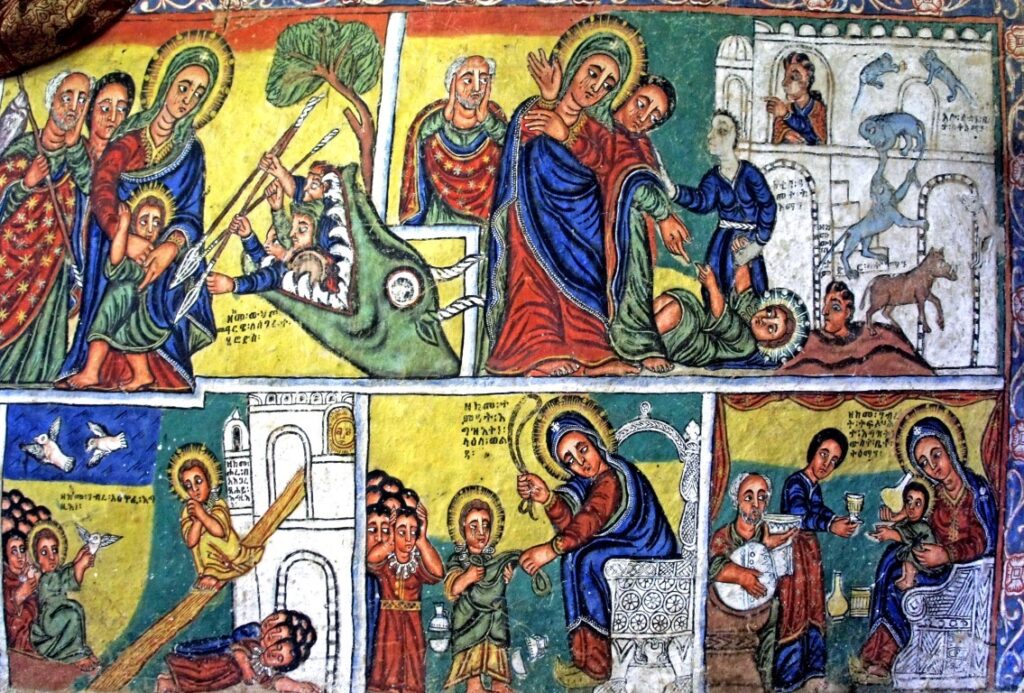
THE SOUTH WALL
women enter a church via the south wall, men via the north wall, the iconographical program is adapted to gender. so this image tells you clearly which wall you are standing in front of. we mentioned before that on the north wall you will find equestrian saints and/or other holy male saints suffering from a variety of tortures.
on the south wall saint mary, her motherhood and other activities are depicted. the most acceptable representative of all women is of course the mother of jesus. mary is depicted four times on this part of the south wall.
the ethiopian church disposes of more holy books than western churches. some examples:
– te’ammere iyesus – the infancy miracles of jesus
– te’ammere maryam – the miracles of our lady mary
– one hundred & ten miracles of our lady mary
– legends of our lady mary, the perpetual virgin, and her mother hannah
– les miracles de jésus
– the apocryphal greek gospel of thomas
– the synaxarium, a church book discribing for each day of the year the life of a saint.

on the south side of the makdas drum the miracle at metmaq is told from the books te’ammere maryam and the synaxarium. debre metmaq is a church in the nile delta. when mary and jesus passed the nile delta during their flight into egypt, jesus fortold to his mother that one day a church would be built there, both in her name and in his. that prediction was an infancy miracle of jesus. what actually happened there is a miracle of mary. this church, part of an egyptian monastery, was known amongst ethiopians as debre metmaq.
the feast at debre metmaq
this feast was instituted to celebrate an event that occurred annually in the dhurch of debre metmaq. during the middle ages (1400), at the end of the month of may. the holy virgin appeared five days in a row to many monks of debre metmaq and to many others, both christians and non christians (muslims). our lady was seated in a circle of light in the vault of the church, accompanied by the archangels michael and gabriel.
all heavenly hosts surrounded her. the cherubim were prostrating themselves repeatedly praising her. the seraphim were cercling around holding censors in praise. and then saint george came in followed by equestrian saints, martyrs and prophets. they all prostrated themselves before her while paying their respects. she blessed them and they would turn around and go back.
and look! the innocent children whom herod killed, entered to sing for her. they were jumping and embracing each other.
when the others heard and saw this, they were rejoycing and it was as though they were in heaven.
if those who had lost a father or mother or other loved ones, asked our lady to meet them, she immediately brought them out in the shape they had before dying,
in addition people would toss their handkerchiefs to her. she would seize the handkerchief she wanted, bless it and throw it back down. and they would tear this relic into pieces and divide it amongst themselves. this was a convincing sign that the holy mother of god was really there.
this miraculous event lasted for five days. whenever they wanted to return to their homes, they prostrated themselves in front of the holy virgin and bid her farewell. then she would bless them with the sign of the cross in her hand. and they would go home only to come back a year later, when she would appear again for five days, year after year.

at the bottom of the previous picture are the following details:
– a woman tossing her brown handkerchief to our lady mary who seized it.
– the church
– people meeting their loved ones from heaven
– a devil leading a naked mohammed on a camel. he was responsable for the destruction of the church
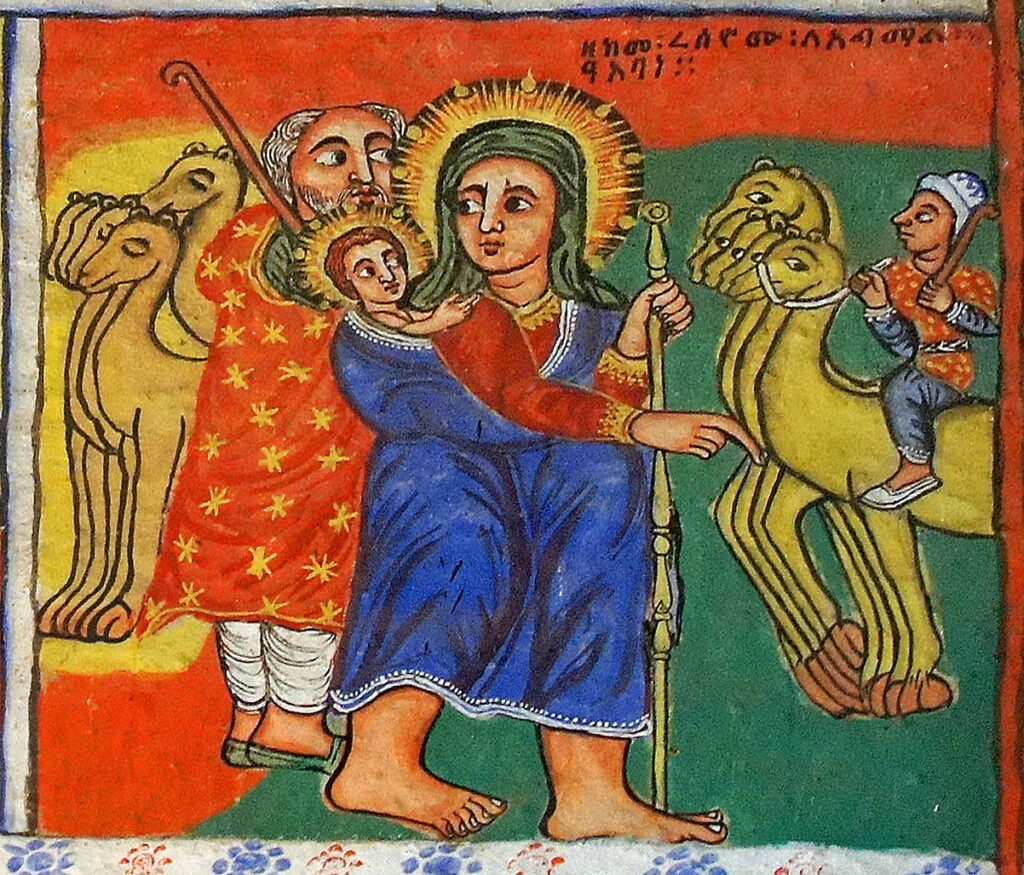
during the flight into egypt the virgin mary payed a visit to patriarch theophilus of alexandria. she told him this story that is published in the book legends of our lady mary. she said: “when we passed through the city of ashmunen five camels came towards us on the road. when my son saw them he ordered them to stand still, and they became stones when we passed them”.
mary did not mention her fear for the animals. she turns at jesus on her back while she points to the five camels and their rider in front of her. neither mary nor joseph seems at ease. but they have now passed the camels and mary notes the comforting image of the camels now in stone, eyes closed and in a different back ground.

in the previous picture the two different backgrounds indicate two different moments within the same story. here they separate two different miracles.
the left one shows the miracle of the birds of clay, related in the gospel of thomas. jesus and his friends are sitting on the ground making birds of clay, every time jesus finishes one, he throws it up and his birds fly. his envious friends are less successful.
to the right, miracle 17 from les miracles de jésus is shown, titled jesus slides on a sunbeam. top left the sun enters the house through a window and leaves throught the opposite door. jesus climbed on to it and he is seen sliding down while sitting on a mat to protect his bottom, when his unfortunate friends do the same, they drop dead in front of the house. when their parents complain jesus is good enough to ensure their resurrection.
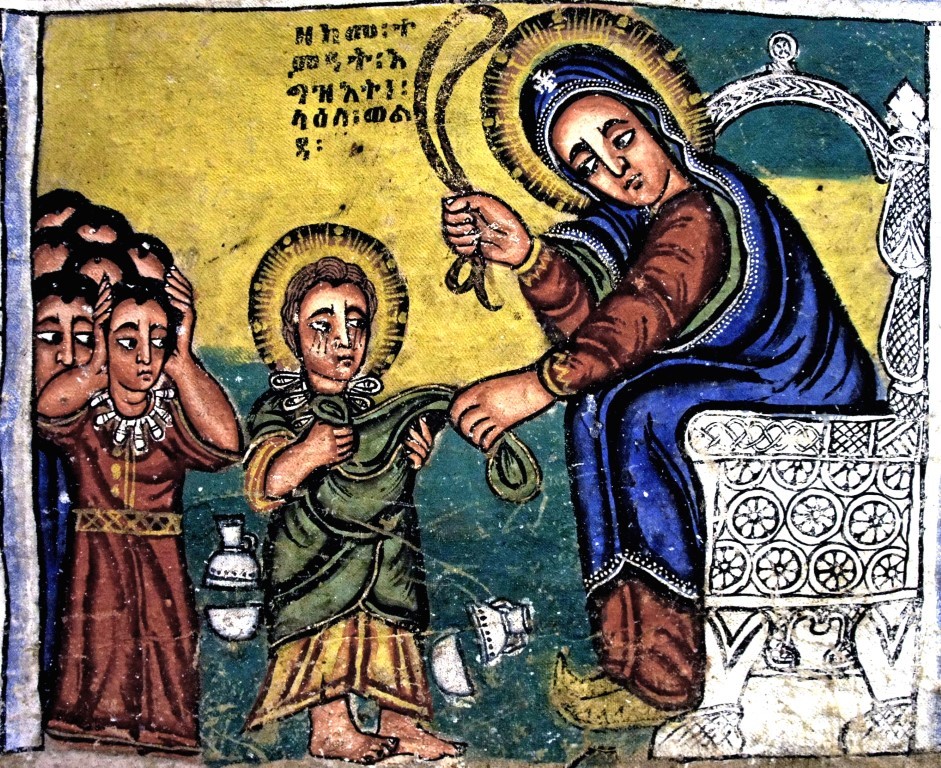
the miracle of the broken water pither.
the story is told in the gospel of thomas. when jesus was six years old, mother mary sent him to fetch water. on his return he handed over the water jar, but just before she could take it he dropped it. his mother thought he did so on purpose, took a rope and spanked him, to the horror of his friends. only then she noticed that he had gathered the water in his lap by holding up two tails of his coat. somewhat embarrassed but also impressed by this miracle, mary helped her weeping son by pouring the water back into a pitcher.
